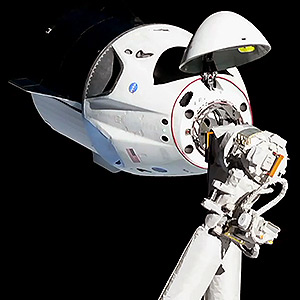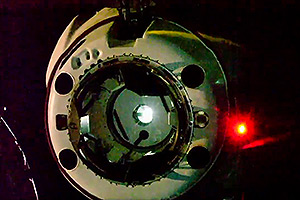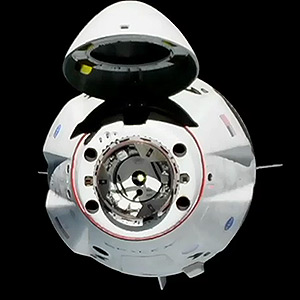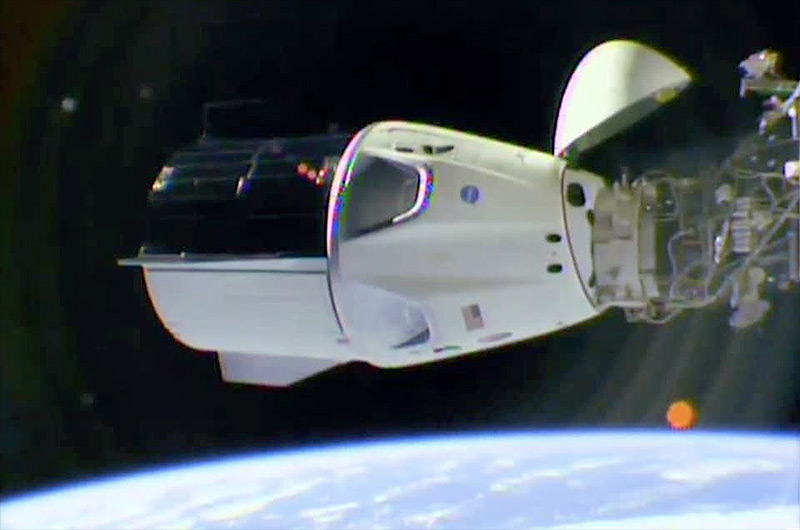 advertisements advertisements
|

|
SpaceX Crew Dragon docks to space station on first demo mission
March 3, 2019 — SpaceX's first Crew Dragon spacecraft has successfully docked at the International Space Station.
The commercially-developed, uncrewed space capsule arrived at the orbiting lab on Sunday (March 3), completing a one-day rendezvous in Earth orbit since launching from the Kennedy Space Center in Florida on Saturday. The docking marked a significant milestone in the Crew Dragon's Demo-1 (DM-1) mission, which is aimed at demonstrating to NASA that the vehicle is ready to begin flying with astronauts aboard.
"Congratulations to all the teams on a successful docking," said Anne McClain, an Expedition 58 flight engineer and NASA astronaut, from aboard the space station.
The Crew Dragon linked up with the space station at 5:51 a.m. EST (1051 GMT), latching itself to an international docking adapter mounted to the end of a shuttle-era pressurized mating adapter (PMA-2) on the forward-facing port of the Node 2 "Harmony" module. A series of 12 latches on the Dragon's nose-mounted docking mechanism were driven closed to achieve a hard docking about 10 minutes later.
Aboard the space station, McClain, together with Expedition 58 commander Oleg Kononenko of Roscosmos and flight engineer David Saint-Jacques of the Canadian Space Agency monitored the Crew Dragon's approach. Unlike SpaceX's cargo version of the Dragon, which is captured and berthed by the space station's Canadarm2 robotic arm, the Crew Dragon flew an autonomous docking.
Before it docked, the Demo-1 Crew Dragon carried out a series of test maneuvers to show it would not pose a danger as it moved in closer to the space station.
The spacecraft began its proximity operations at about 500 feet out (150 meters) from the station. Approaching on the V-bar, along the station's direction of travel, the Crew Dragon's first test was initiated by the Expedition 58 crew, who issued a planned command for the spacecraft to retreat. In response, the capsule reversed course and moved out to about 600 feet (180 meters).
Once SpaceX's mission managers in Hawthorne, California and NASA's flight controllers in Houston, Texas gave the go, the Crew Dragon was cleared to move to within 65 feet (20 meters) of the station. The spacecraft was then commanded to proceed to a docking after a brief pause to wait for the orbital sunset.
The entire approach, from an initial waypoint about 1,300 feet (400 meters) away from the space station, took about two hours to complete.
With the Dragon docked, attention turned to opening the hatches leading into the vehicle. The Expedition 58 crew members will unpack the spacecraft of the 450 pounds (200 kilograms) of supplies and equipment it brought to the space station. They will then reload the Dragon with science results and hardware for return to Earth.
The Crew Dragon is scheduled to remain at the station for five days, until about 2:30 a.m. on Friday (March 8). The spacecraft is expected to splash down in the Atlantic Ocean a little more than six hours after it undocks.
Assuming a successful end to the DM-1 mission, SpaceX has one more unpiloted test — an inflight abort test — planned for this year before launching a crewed flight test. NASA has selected veteran space shuttle astronauts Bob Behnken and Doug Hurley to fly on the Demo-2 (DM-2) mission, which could launch as soon as June.
"Bob and I are ready to go when Dragon is ready. Whenever that happens, we are going to be ready to take that ride to the International Space Station," said Hurley.
SpaceX's Crew Dragon is one of two new commercial spacecraft that NASA has contracted to fly astronauts to and from the International Space Station. Boeing is also developing a capsule, the CST-100 Starliner, and is still working towards its first uncrewed mission to the space station. |
|

SpaceX's Crew Dragon approaches a docking with the International Space Station at a distance of 65 feet (20 m). Part of the space station's Canadarm2 robotic arm is seen in the foreground. (NASA)

SpaceX's Crew Dragon is seen moments before docking with the International Space Station on Sunday, March 3, 2019. (NASA)

SpaceX's Crew Dragon approaches the International Space Station with nosecone retracted, exposing its docking mechanism. (NASA)
|

SpaceX's Demo-1 (DM-1) Crew Dragon seen docked from a video camera aboard the International Space Station on Sunday, March 3, 2019. (NASA) |
|

© 1999-2024 collectSPACE. All rights reserved.
|
|

|

|
